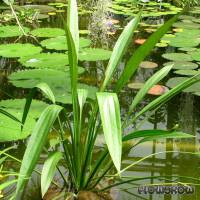



In 1994, Echinodorus decumbens was discovered by Christel Kasselmann on Rio Surubim in the eastern Brazilian state Piauí. Later on it was scientifically described by her, too. Up to now, this species has only been found in that location, where it grows directly on the banks as well as in indundation zones of the river. Once imported into Germany, E. decumbens was cultivated and quickly spread in the hobby; today, it is frequently offered in trade.
Its scientific name means "low-lying sword plant", which only refers to its decumbent, i.e. creeping flower stalks; the leaf rosette has an upright growth habit.
E. decumbens is closely related to E. subalatus, and its emersed form differs from it - amongst other characteristics - by its decumbent (instead of upright) flower stalks, which grow distinctly larger than the leaves and whose flower whorls grow at larger distances. Its lanceolate leaves are generally narrower than those of E. subalatus. Its flower stalk axils are triangular, but not alate like those of E. subalatus. Like the latter and also like the related species E. palaefolius, E. decumbens has angled leaf stalks with a groove on the upper side, long, very narrow bracts on the whorls of the flower stalk as well as short-stalked relatively small flowers whose petals do not overlap and with 12 pale yellow stamina. The E. decumbens clone in cultivation in the hobby is self-sterile, i.e. its flowers do not develop into fruit after pollination with pollen of this clone.
Its submersed leaves grow to a length of over 50 cm and have long, strong stalks. The leaf blades are very narrow, lineal to band-shaped, and relatively robust (distinctly narrower thant those of the emersed plant in fig. 1). The midrib is strong and of a lighter colour than the rest of the leaf tissue, which is quite often slightly transparent. The submersed form of this species looks a bit like that of the rarely cultivated Echinodorus paniculatus, which is not closer related, though.
In the aquarium, E. decumbens is a rather fast, adaptable grower, however, it needs good lighting and a substrate rich in nutrients. This species originates from the hot climates in eastern Brazil and thus prefers higher temperatures of at least 25 °C in the aquarium; it still grows well at temperatures of around 30 °C, which makes it a good plant for aquaria like discus fish that prefer warm water. Even though it grows in very soft, slightly acidic water in the habitat it can also be cultivated in moderately hard, slightly alkaline water.
Grown plants are only suitable for rather high tanks as they grow to a height of up to 75 cm. However, young plants can be used in smaller aquaria until they start growing out. Strong plants may tend to form emersed leaves, however, after they have been removed, the plant usually sprouts submersed leaves again.
When cultivated under greenhouse conditions, the emersed form of E. decumbens reproduces readily by forming adventitious plants on the flower stalks it regularly sprouts. Strong submersed plant may also sprout flower stalks, however, those will develop an upright growth habit, other than the decumbent stalks formed by emersed plants.
Despite its size, E. decumbens has an unobtrusive rather informal look in the aquarium due to its very narrow, long-stalked leaves. When planted in the middleground of a large tank, the loosely arranged leaves of this sword plant allow a relatively free view of the background, don't shade off their neighbours and can thus e.g. be combined with small-leaved stem plants very well. A group of large E. decumbens plants in the background of an aquarium may remind the onlooker of a group of reeds. As narrow-leaved large rosulate plant E. decumbens fits greatly into a Nature Aquarium layout and should definitely get more attention in aquascaping as has hitherto been the case.
<a href="https://www.flowgrow.de/db/aquaticplants/echinodorus-decumbens" target="_blank"><img alt="Echinodorus decumbens" title="Echinodorus decumbens" src="https://www.flowgrow.de/db/widget/aquaticplants/echinodorus-decumbens" /></a>
[url=https://www.flowgrow.de/db/aquaticplants/echinodorus-decumbens][img]https://www.flowgrow.de/db/widget/aquaticplants/echinodorus-decumbens[/img][/url]
[widget=aquaticplants/echinodorus-decumbens]Echinodorus decumbens[/widget]